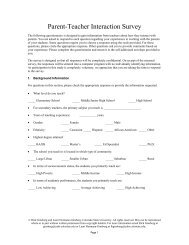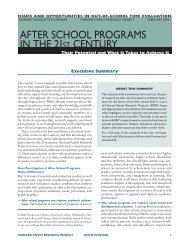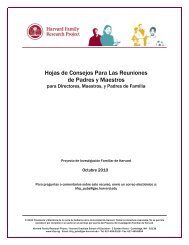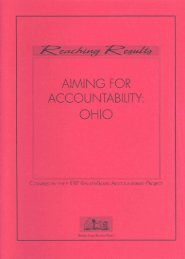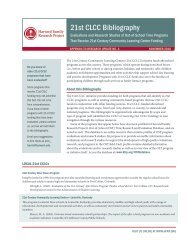Download a PDF of this case study - Harvard Family Research Project
Download a PDF of this case study - Harvard Family Research Project
Download a PDF of this case study - Harvard Family Research Project
You also want an ePaper? Increase the reach of your titles
YUMPU automatically turns print PDFs into web optimized ePapers that Google loves.
In line with these research findings, the Network requires members to include a budget<br />
line for their planned partnership activities. The Network has also assessed and shared<br />
local funding information with members. Common sources include federal funds, such as<br />
Bilingual Education, Drug Prevention, Even Start, Goals 2000, Special Education and Title<br />
I, VI, and VII, as well as state, district and private sources. One-third <strong>of</strong> schools have<br />
written grant proposals to fund their family-school partnership programs; nearly threefourths<br />
<strong>of</strong> these proposals have been funded (Sanders, 1998). Average per-pupil<br />
expenditures at the school, district, and state level also have been calculated by the<br />
Network, which may help members judge their funding requirements.<br />
The Network also alerts members to funding sources and opportunities through its<br />
newsletter, web site, and special notices (Sanders, 1998). This funding information may<br />
be particularly valuable for school programs’ longevity, which has been shown to predict<br />
the quality <strong>of</strong> schools’ partnership programs (Sanders, 1998). This is also true for the<br />
longevity <strong>of</strong> district programs (Epstein, Sanders, Clark, & Van Voorhis, 1999).<br />
The Network is constantly using research to adapt its support, including an upcoming<br />
handbook revision and new partnership planner. Improvements and additions to the<br />
Network’s web site, training workshops, recruitment tools, planning tools, and training tools<br />
also are in process. The development <strong>of</strong> an informational video and special training videos<br />
are now underway.<br />
In addition to measuring the success <strong>of</strong> the Network in supporting quality programs and<br />
adapting its practices accordingly, evaluations are also underway to understand the<br />
broader impact <strong>of</strong> partnership programs, especially on student achievement. Individual<br />
studies reveal promising results. For example, two studies <strong>of</strong> Teachers Involve Parents<br />
(TIPS) programs, a component <strong>of</strong> the Network curriculum, showed positive outcomes for<br />
students in the middle grades. Positive effects range from increased awareness <strong>of</strong> and<br />
preference for subject matter, to the quality <strong>of</strong> students’ writing assignments and end-<strong>of</strong>year<br />
report card grades (Epstein & Dauber, 1995; Epstein, Simon, & Salinas, 1997).<br />
A <strong>study</strong> <strong>of</strong> Baltimore schools also showed that partnership programs have positive effects<br />
on students. Controlling for prior attendance and student mobility, high quality partnership<br />
programs were associated with significant improvements in attendance among middle and<br />
high school students. High quality programs also significantly improved third graders’<br />
achievement in math and especially reading and writing, as measured by state<br />
performance assessments (Epstein, Clark, Salinas, & Sanders, 1997). Another <strong>study</strong><br />
examined the effects <strong>of</strong> school, home, and community effects on the academic<br />
achievement <strong>of</strong> African American adolescents and found that home, school, and church<br />
support, and the combination <strong>of</strong> these supports, positively affected students' attitudes and<br />
behaviors, which in turn, positively influenced their academic achievement (Sanders,<br />
1998).<br />
A more comprehensive data collection effort is well underway. So far data have been<br />
collected on attendance, math achievement, and behavior. Data collection on reading<br />
achievement is in progress in the 1999-2000 year. Each year, the Network collects <strong>this</strong><br />
data on a different topic through a voluntary survey <strong>of</strong> partnership schools. A recently hired<br />
post-doctoral fellow has begun to analyze <strong>this</strong> data. <strong>Research</strong> reports and practical<br />
products are planned.<br />
The Network is also committed to helping schools, districts, and states become learning<br />
organizations themselves. In addition to providing general information about school<br />
programs <strong>of</strong> partnership, the Network has recently <strong>of</strong>fered to synthesize district and statespecific<br />
evaluation data for members whose districts or states have a sizable number <strong>of</strong><br />
partnership programs. The Network also provides members with a plethora <strong>of</strong> evaluation<br />
tools and advice, including scoring rubrics, end-<strong>of</strong>-year evaluation forms, inventories <strong>of</strong><br />
- 14 -





